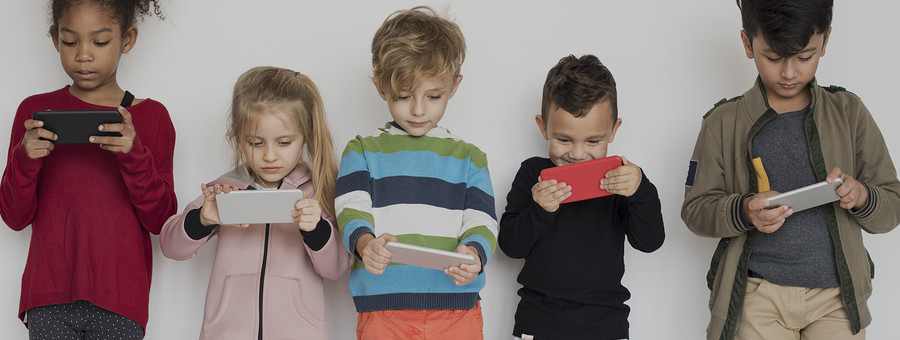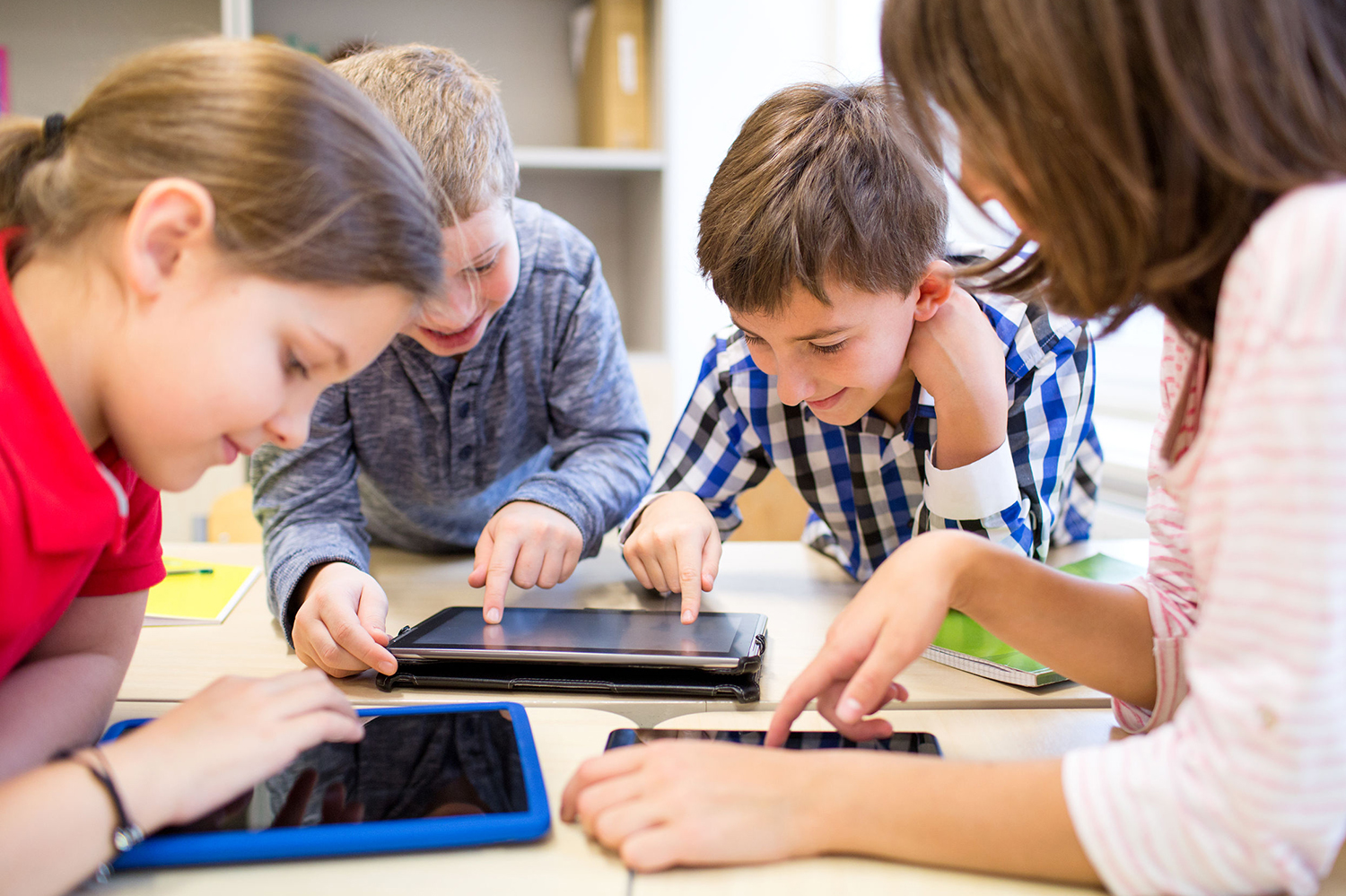How many times have you seen a barely two-year-old playing games or YouTube videos on a tablet, perfectly managing all the options? Or a typical group of teenagers sitting at a coffee place, being completely engaged into social networking on their phones, instead of having an actual live conversation with their peers? In the age of rapid technological expansion, dynamic lifestyle and social media overuse, children are being ever more and earlier exposed to technology, including the entertainment kinds, such as TV, iPads, smartphones, tablets…

A couple of decades ago, streets were full of kids playing hide-and-seek and similar outdoor games, while nowadays, they mostly find fun in more virtual environments, spending hours online gaming after school.
Clearly, advancement in technology has its undeniable perks, education quality, facilitation and modernization being the most prominent ones, particularly in the case of children. However, one cannot help but wonder when would be the most appropriate timing to introduce youngsters to the great variety of technological advantages.
Technology is incorporated in almost every single aspect of our lives on a daily basis, and there is a raising concern about how it affects younger population. The amount of time children spend using laptops, tablets, smart phones and other devices is alarming, not only for their physical condition, but also for imagination, social skills, empathy and the growing detachment from the environment and other people. Recent study results show that kids and teens between eight and eighteen years of age spend averagely seven hours and thirty-eight minutes per day using media technology. Other set of studies, conducted exclusively on adolescents, prove that they are having difficulties identifying emotions, and consequently, empathizing.
How does technology influence children?

Too much reliance on technological devices during their play limits creativity and imagination, which consequently leads to decreased challenges in children’s brains to attain sensory and motor development. This chaotic sensory stimulation has a negative impact on achieving literacy, as well as on overall attention and focus that children have when entering school.
Apart from psychological and behavioral, the effect of overusing constantly advancing technology is also physical: many health issues and diseases that young children often suffer (obesity, diabetes, ADHD, autism, anxiety, depression, sleep disorder, learning difficulties..) seem to be at least partly caused by it.
The necessary requirement for adequate development is touch, movement, human connection, and more exposure to nature. Touching and hugging activate tactile stimulation responsible for acquisition of appropriate movement patterns, and have an influence on lowering the level of adrenaline and cortisol. Nature, besides being calming, improves attention and helps learning.
Thus, technology overuse lessens the stimulation of tactile and attachment systems, but it overstimulates visual and auditory systems, which disturbs neurological development, altering brain chemistry and anatomy. For example, violence through video games or movies increases adrenaline and stress, causes shaking and faster heart rate. Moreover, it numbs the sensitivity of young people and makes them less capable of compassion and sympathy.
On the other hand, media helps youngsters connect with others and with the world. It is an unlimited source of information, it adds to their understanding of basically everything surrounding them, and enables exchange of opinions on different topics through common platforms. Besides aiding socialization, media technology provides children with numerous possibilities of making their voices heard and learning about other perspectives.
Video games have positive impact as well, since they improve logical thinking, teach teamwork and sharing, develop motor skills and hand-eye coordination. Text messaging also proves to have beneficial effects, namely on reading skills and language in general.
Today, there is even media technology specially designed for enhancing emotional and social learning, which can improve empathy and relationships with other people.
So, technology can help children develop in many ways when used in balance. The advantages it provides should be accepted and used, yet the drawbacks could be reduced as much as possible. It does give a challenging task to parents, though: to perceive both sides and teach their children to create a balance. From an early age all the way through adolescence, they should try to keep track of kids’ habits of technology employment.
So… when?
As soon as young children start being curious about exploring the world around them, they begin taking different objects in their hands, touching and pressing them. This obviously includes electronic gadgets, computers, phones, remote controls, tablets and the rest. Learning how to tap objects to make them move is quite natural and easy for them. But the arbitrary and automatic pressing and pushing buttons does not mean that they are already capable of using technological devices.
Some groups of experts do not recommend introducing children to all kinds of technology before preschool age, while the majority agrees that it is not appropriate until they turn two, since until that age kids learn most efficiently from real experiences, so computers are more threatening to their sensory development than they are useful.
However, many three-year-olds are able to benefit from media with educational content. Thus, this is a strongly individual question- some children are ready to become media users sooner, some a little or a lot later. Still, there is a common trait that can be perceived: all children, regardless of age, should be monitored when employing technology. A moderate amount of supervision, depending on a child’s character and needs, is the key to the successful use of technology for the purposes of an optimal brain development.
There is more than one good reason to introduce children to technology earlier than school age. Apart from educational opportunities that it offers, early practices with digital mechanisms prepare children for better performances during school or college years, as well as later work careers, as technological literacy is essential in the twenty-first century, and the new generations are expected to be more literate than the previous ones. Study reports display that kids who start using smartphones or tablets earlier grasp virtual contents more easily, learn it faster and make fewer mistakes. Another reason is the quality of creative outlet that technology provides: although it cannot replace the actual tactile sensations experienced when building blocks or drawing shapes, it does offer a wide choice of possibilities to express creativity, for example, drawing apps.
Many preschools and kindergartens have begun to use computers, tablets and other electronic devices in their programs. In schools, this is even more common, since computer-based learning has spread to all fields of teaching and it gives a whole new dimension, another layer beyond the classical one, which simply includes a blackboard and a notebook. According to one survey, two-thirds of kids from two to ten years old possess tablets or electronic readers, while more than eight in ten children use digital media weekly.
The best way to supervise children’s use of technology is to actually use it with them, to keep them company and guide them. Playing games together, reading or watching videos will both provide them with the most beneficial content and ensure that digital media is used responsibly. As they grow older, their use will change and evolve, the content they take interest into will become wider, but parental engagement and monitoring will remain an important factor for their children’s healthy relationship with technology.
So, parallelly to the issue of technological impact on children’s development, the question of when is the right time for their introduction to it seems to have only one, though vague, answer, and that would be- balance. Kids of all ages, including adolescents, should spend a moderate amount of time using different digital media, extracting the positive effects as much as possible and avoiding the negative ones. Similarly, they should not be rushed to start using it too early, since it can cause more damage to their development, but also, it does have many benefits which they can make use of later; moreover, they will face it sooner or later anyway, because it has become crucial in practically all work areas. Again, parental supervision and monitoring is an important factor at all costs, though it should be balanced as well.
Arnold Gibson is a writer, developer and digital marketer. He is a tech enthusiastic person and like to write on latest topics about technology, gadgets reviews, techs update and more. You can visit his website AudioReputation.com and find a lot of information.